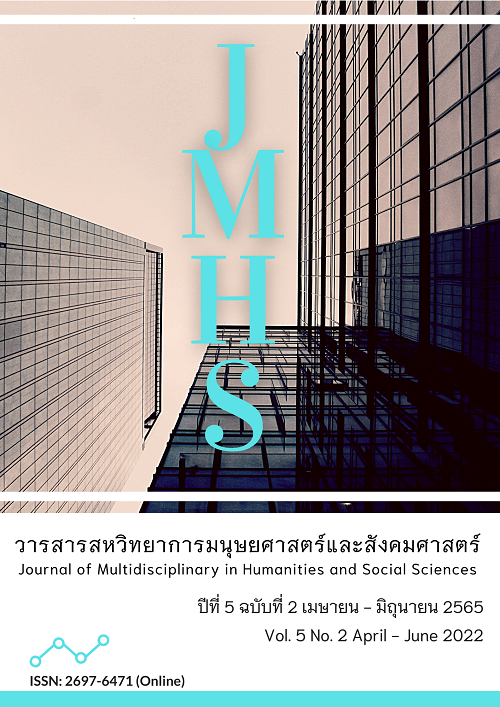A Study of Tranquility of The Mind In Ānāpānasati Sutta According to Theravada Buddhist Scripture
Main Article Content
Abstract
The objectives of this article were 1) to study the essence and teaching in Ānāpāṇasati Sutta and 2) to study the Tranquility practice in Ānāpāṇasati Sutta. This was documentary research taken from Theravada texts and other relevant documents, summarized, compiled, and written in descriptive type. The findings were that Ānāpānasati practice with 16 gradual stages is called Samathayānika or tranquility type, which focuses on serenity of mind as a main vehicle or having Samatha as a guide. In the first Catukka, the 1-4 stage is the determination of internal knowledge called Kāyānupassanāsatipaṭṭhāna, i.e., noting an exhaling-in-long, an exhale-in short, while exhale-in observing, knowing the whole wind that touches the whole body with exhale in-out, seeing all the winds while being calm. In the second Catukka, 5-8 stages are involved with clear mindfulness of subtle feelings called Vedanānupassanā. The practitioners distinguish the form-noun while breathing in-out, realizing all mental states while breathing in-out, suppressing all mental states and realizing the profound and beneficial experiences as mentioned in Vedanānupassanā. In the third Catukka, the 9-12 stage refers to the state of clear mindfulness contemplating on consciousness called Cittānupassana, realizing the factors of the noun-form clearly while breathing in and out, the strength of the mind while breathing in-out, abandoning mental conditions as they appear in Cittānupassanā. In the fourth Catukka, 13–16 stages deal with mindfulness on breathing out-in, observing the impermanence, suffering, and non-self in the five aggregates, and knowing the profound and beneficial Dhamma mentioned in Dhammānupassanā. This breath mindfulness with complete and well-done will surely lead to Mahasatipatthana, complete Mahasatipatthana cultivation will lead to complete seven Bojjhanga which later will enter to the final realization and liberation in final.
Article Details

This work is licensed under a Creative Commons Attribution-NonCommercial-NoDerivatives 4.0 International License.
Views and opinions appearing in the Journal it is the responsibility of the author of the article, and does not constitute the view and responsibility of the editorial team.
References
จิรพร ชีวะธรรม และ อุทัย สติมั่น. (2564). วิเคราะห์การพัฒนาชีวิตตามหลักธรรมที่ปรากฏในพระไตรปิฎก. วารสาร มจร บาฬีศึกษาพุทธโฆสปริทรรศน์, 7(1), 96-106.
ชัยชาญ ศรีหานู. (2564). วิเคราะห์คำสอนวิปัสสนาในเตภูมิกถาที่มีผลต่อคตินิยมเชิงพุทธในสังคมไทย. วารสาร มจร บาฬีศึกษาพุทธโฆสปริทรรศน์, 7(1), 12-26.
พระพรหมคุณาภรณ์ (ป.อ.ปยุตฺโต), (2559). พจนานุกรมพุทธศาสตร์ ฉบับประมวลธรรม. (พิมพ์ครั้งที่ 34). กรุงเทพฯ: มูลนิธิการศึกษาเพื่อสันติภาพ.
พระพุทธโฆสเถระ. (2554). คัมภีร์วิสุทธิมรรค. (สมเด็จพระพุฒาจารย์ (อาจ อาสภมหาเถร), แปล). (พิมพ์ครั้งที่ 10). กรุงเทพฯ: ธนาเพรส.
พระมหานพดล นวตลปญฺโญ, พระครูสุธีคัมภีรญาณ (ประมวล) และ พระมหามิตร ฐิตปญฺโญ. (2564). รูปแบบการปฏิบัติธุดงควัตรของพระสงฆ์ในลุ่มแม่น้ำโขง (ไทย-ลาว). วารสารศิลปการจัดการ, 5(2), 325-339.
พระสมชาย บัวแก้ว, พระมหาบุญศรี วงค์แก้ว และ สุเชาวน์ พลอยชุม. (2564). อภิสมาจาร: กระบวนการพัฒนาบุคลิกภาพตามแนวพระพุทธศาสนา. วารสารศิลปการจัดการ, 5(3), 895-907.
พระสัทธัมมโชติกะ ธัมมาจริยะ. (2554). ปรมัตถโชติกะ ปริจเฉทที่ 9 เล่ม 1 สมถกรรมฐานทีปนี. (พิมพ์ครั้งที่ 6). กรุงเทพฯ: มูลนิธิสัทธัมมโชติกะ.
พระโสภณมหาเถระ (มหาสีสยาดอ) (2548). วิปัสสนานัย เล่ม 1. (พระคันธสาราภิวงศ์, แปล). กรุงเทพฯ: ประยูรสาส์นไทย การพิมพ์.
พุทธทาสภิกขุ. (2518). อานาปานสติภาวนา. กรุงเทพฯ: ห้างหุ้นส่วนจํากัดการพิมพ์พระนคร.
มหาจุฬาลงกรณราชวิทยาลัย. (2539). พระไตรปิฎกภาษาไทย ฉบับมหาจุฬาลงกรณราชวิทยาลัย. กรุงเทพฯ: โรงพิมพ์มหาจุฬาลงกรณราชวิทยาลัย.
มหาจุฬาลงกรณราชวิทยาลัย. (2552). อรรถกถาภาษาไทย ฉบับมหาจุฬาลงกรณราชวิทยาลัย. กรุงเทพฯ: โรงพิมพ์มหาจุฬาลงกรณราชวิทยาลัย.
อรชร ไกรจักร์, เเม่ชีกฤษณา รักษาโฉม และ พระมหาวรัญธรณ์ ญาณกิตฺติ. (2564). บุคลิกภาพของพระภิกษุตามหลักเวสารัชชกรณธรรม. วารสาร มจร บาฬีศึกษาพุทธโฆสปริทรรศน์, 7(3), 113-125.
Chanthathong, S. (2021). The Significance of the Right View (Sammaditthi) in Theravada Buddhism. Journal of International Buddhist Studies, 12(1), 61-70.
Tan, C. C., & Damnoen, P. S. (2020). Buddhist Noble Eightfold Path Approach in the Study of Consumer and Organizational Behaviors. Journal of MCU Peace Studies, 8(1), 1–20.


